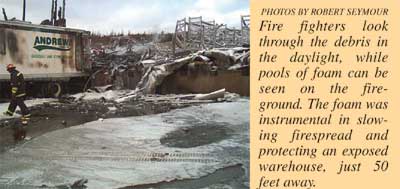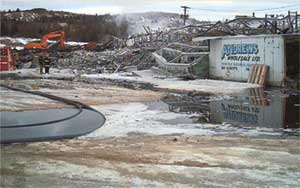
Features
Hot topics
Incident reports
Warehouse Inferno:Use of foam was key to containing the fire and saving a second, exposed warehouse
While the fire that consumed the Andrews Warehouse in Bay Roberts, N.L., was too advanced to save, quick actions by the fire service in this community combined with a rapid deployment of foam streams ensured it would not reach another warehouse just 50 feet away.
December 17, 2007
By Robert Lynch and Robert Seymour
While the fire that consumed the Andrews Warehouse in Bay Roberts, N.L., was too advanced to save, quick actions by the fire service in this community combined with a rapid deployment of foam streams ensured it would not reach another warehouse just 50 feet away.
On Thursday, Dec. 30, 2004 at 5:15 p.m. a page went out to the Bay Roberts (N.L.) Volunteer Fire Department that a “truck” was on fire in front of Andrews Wholesale on Hope Avenue. Bay Roberts dispatched Pumper 3 with a full complement of fire fighters to the scene. Fire Chief Clarence Russell, en route from his own residence and with full view of the warehouse, determined that the fire was much more than a truck. He immediately dispatched Pumper 2 as well as all other available resources to respond.
Upon arrival on scene Pumper 3 picked up the first hydrant and the initial attack began at the front of the building. With Pumper 2 now on the scene and the second attack team in place, Class A foam was applied to the loading bay area, on the warehouse trucks parked there and to the warehouse itself. Bay Roberts applied approximately one full tank of Class A foam to this area alone. The chief soon realized that the incident was getting out of control. “I could see from my house that it was a much bigger problem than first paged,” said Russell. “I knew we would need help. Even with the foam we used, I knew we would need more to battle this blaze.”
 Command set up
Command set up
A command centre was then set up and Lieut. Kevin Greenland was instructed by the chief to call the Spaniard’s Bay Fire Department for mutual aid. While this was being executed, Russell was in a telephone conversation with Fire Chief Paul Snow of the Harbour Grace Volunteer Fire Brigade.
Both chief officers agreed that Harbour Grace would send one of its pumpers immediately. The Upper Island Cove Fire Department was also called and put on stand-by to cover the towns of Spaniard’s Bay and Bay Roberts. Upon arrival, the Spaniard’s Bay Fire Department truck was placed by command at the west side of the building. Shortly after Harbour Grace’s arrival on scene, it was determined that its attack team would take up position at the east side of the neighbouring warehouse, Atlantic Grocery, which was approximately 50 feet from the burning inferno.
Large exposure protected
Harbour Grace’s Pumper #4 was placed at the Atlantic Grocery in a defensive capacity. Foam percentage was set at one (1.0) per cent and fire fighters blanketed the warehouse with Class A foam providing complete protection for that exposure. Having ensured this protection of Atlantic Grocery, the brigade then covered stacks of pallets and a nearby container, preventing any possible spread of fire onto these. Using this setting (one per cent) the Brigade dispensed 12 gallons of Class A foam on the structures, ensuring no breach of the coverage was possible.
A short time later the Cupids and Brigus fire departments arrived at the scene. Also at this time, Fire Chief Scott Thomas of the Carbonear Fire Department called to inform Chief Russell that he had sent his aerial ladder truck to the scene for assistance.
Interior attack mounted
The Spaniard’s Bay pumper was set up at the west end of the building with a water supply from a nearby river. Capt. Glenn Bradbury and Firefighter Dave Churchill entered the new extension at the rear of the building, which was yet to be involved with fire, to begin an interior attack. Making their way toward the front of the building it was soon realized because of heavy smoke and extreme heat that this attack would have to be aborted. Meanwhile, at the east side of the building the fire was breaking out through the eaves next to the high voltage power lines that were supplying both buildings. At that point command centre made the call to Newfoundland Power to cut all power to the area.
Water supply secured
Cupids and Brigus fire departments laid supply lines from a nearby brook to the Harbour Grace pumper which gave them an ample supply of water to apply foam to the rear of Atlantic Grocery. This was later determined to have been the saving grace for this warehouse, which sustained no damage as a result of this incident.
In all, six pumpers, three equipment vans, three rescue trucks and 75 fire fighters battled the blaze for 4-1/2 hours. At approximately 9 p.m. Russell told Spaniard’s Bay, Cupids and Brigus fire departments to break down and load their equipment and return to their respective stations. Bay Roberts and Harbour Grace remained at the scene, knocking down stubborn hot spots.
Second call received
While returning to the station, a second call came into the Bay Roberts paging system reporting a structural fire on the main road in Shearstown. Chief Russell notified Spaniard’s Bay of the call and requested them to respond.
At 12:00 a.m., Russell called for town manager Ed Fradsham to meet at the command centre to inform him that due to the size of the area and collapse of the structure and its contents that an excavator would be needed to pick through hot spots. Russell then notified Fire Commissioner Fred Hollett that he had determined that the fire started at the front of the building and would protect this area for investigation purposes while the excavator worked at the scene. At 3:30 a.m. a crew of six fire fighters and a pumper were assigned to remain at the scene while the rest of the fire fighters were released to return to their station and begin the task of cleaning gear.
Multi-million dollar loss
The loss was estimated to be about $5-million. Twenty-five jobs have been displaced due to the incident.
One eyewitness reported: “When we arrived at the scene, we could see the flames flicking over the roof of the structure. The Bay Roberts Fire Department was responding to the scene as we arrived. It was difficult for us to determine whether it was either Andrews Wholesale or (the) nearby Brookside service station that was on fire. It was only when workers moved several vehicles that we were sure it was Andrews Wholesale.”
Value of foam
“Once again the use of Class A Foam, even in a defensive role, proved the value of having such an asset on hand in the battle against fire loss,” said Harbour Grace  Fire Chief Paul Snow. “When we arrived on the scene, the fire was impinging on the second exposure. Class A (foam) bought time for fire fighters until a good water supply was acquired. Having an ample water supply and a co-ordinated attack, fire fighters began to battle the blaze in earnest.”
Fire Chief Paul Snow. “When we arrived on the scene, the fire was impinging on the second exposure. Class A (foam) bought time for fire fighters until a good water supply was acquired. Having an ample water supply and a co-ordinated attack, fire fighters began to battle the blaze in earnest.”
Conclusions
- Rapid application of foam in early stages aided in slowing firespread in the original warehouse and in saving the exposure while a water supply was secured.
- The early call for mutual aid ensured there were enough resources available when needed, and that the rest of the community was protected during the incident.
- Steps were taken to protect the scene for investigation while an excavator was used to expose hot spots.
The department
The Bay Roberts Volunteer Fire Department was formed in 1942 with 15 members and it acquired its first pumper in March 1946. Today the department has a total membership of 30 and elections are held for the positions of chief, assistant chief, fire captain, rescue captain, chief operator, first lieutenant and second lieutenant. An executive body is also elected to manage the business of the department. It responds to approximately 100 calls per year and conducts its own in-house training. Bay Roberts has a full set of rescue/extrication tools, is equipped for high-angle rescue and currently is getting involved in cold water rescue. On the apparatus roster is a 2003 840-Igpm pumper with foam system and 1,000 gallons of water, a 1993 840-Igpm pumper with 800 gallons of water, a 1997 4×4 rescue truck, a 1989 4×4 high-angle/cold water rescue truck, a 1992 rescue/equipment cube van and an antique 1942 pumper. It provides fire protection to a population of 7,000 in an area of about 32 square kilometres and rescue services and vehicle extrication for approximately 60 sq. km., servicing a total population of 17,000. Bay Roberts is located east of St. John’s on the Avalon Peninsula.
Print this page